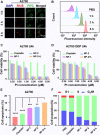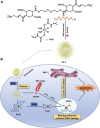Photothermal Therapy via NIR II Light Irradiation Enhances DNA Damage and Endoplasmic Reticulum Stress for Efficient Chemotherapy
- PMID: 33995101
- PMCID: PMC8117088
- DOI: 10.3389/fphar.2021.670207
Photothermal Therapy via NIR II Light Irradiation Enhances DNA Damage and Endoplasmic Reticulum Stress for Efficient Chemotherapy
Abstract
Ovarian cancer has the highest death rate in gynecologic tumors and the main therapy for patients with advanced is chemotherapy based on cisplatin. Additionally, hyperthermic intraperitoneal has been used in clinic to obtain better efficacy for patients. Hence, combined photothermal therapy with platinum drugs in a new delivery system might bring new hope for ovarian cancer. A reduction sensitive polymer encapsulating a Pt (IV) prodrug and a near infrared II (NIR II) photothermal agent IR1048 to form nanoparticles were reported to enhance the efficacy of ovarian cancer treatment. At the same time, endoplasmic reticulum stress indicates an imbalance in proteostasis which probably caused by extrinsic stress such as chemotherapy and the temperature changed. The efficacy of nanoparticles containing Pt (IV) and IR1048 under NIR II light might be caused via increased DNA damage and endoplasmic reticulum (ER) stress.
Keywords: DNA damage; NIR II light; chemotherapy; endoplasmic reticulum stress key; mild hyperthermia; photothermal therapy.
Copyright © 2021 Kong, Wei, Xie, Wang, Yu, Kang and Wang.
Conflict of interest statement
The authors declare that the research was conducted in the absence of any commercial or financial relationships that could be construed as a potential conflict of interest. The handling editor and the reviewer (PM) declared a shared affiliation with the authors at time of review.
Figures




Similar articles
-
Breast Cancer Cell Membrane Camouflaged Lipid Nanoparticles for Tumor-Targeted NIR-II Phototheranostics.Pharmaceutics. 2022 Jun 28;14(7):1367. doi: 10.3390/pharmaceutics14071367. Pharmaceutics. 2022. PMID: 35890265 Free PMC article.
-
Near-Infrared-II Light Induced Mild Hyperthermia Activate Cisplatin-Artemisinin Nanoparticle for Enhanced Chemo/Chemodynamic Therapy and Immunotherapy.Small Methods. 2022 Sep;6(9):e2200379. doi: 10.1002/smtd.202200379. Epub 2022 Aug 17. Small Methods. 2022. PMID: 35978419
-
NIR-II light evokes DNA cross-linking for chemotherapy and immunogenic cell death.Acta Biomater. 2023 Apr 1;160:198-210. doi: 10.1016/j.actbio.2023.02.012. Epub 2023 Feb 13. Acta Biomater. 2023. PMID: 36792048
-
Near-Infrared Light Irradiation Induced Mild Hyperthermia Enhances Glutathione Depletion and DNA Interstrand Cross-Link Formation for Efficient Chemotherapy.ACS Nano. 2020 Nov 24;14(11):14831-14845. doi: 10.1021/acsnano.0c03781. Epub 2020 Oct 21. ACS Nano. 2020. PMID: 33084319
-
Platinum(IV) prodrug conjugated Pd@Au nanoplates for chemotherapy and photothermal therapy.Nanoscale. 2016 Mar 14;8(10):5706-13. doi: 10.1039/c5nr09120a. Nanoscale. 2016. PMID: 26900670
Cited by
-
Targeting Cancer Stem Cells by Dietary Agents: An Important Therapeutic Strategy against Human Malignancies.Int J Mol Sci. 2021 Oct 28;22(21):11669. doi: 10.3390/ijms222111669. Int J Mol Sci. 2021. PMID: 34769099 Free PMC article. Review.
-
UBA1 inhibition contributes radiosensitization of glioblastoma cells via blocking DNA damage repair.Front Pharmacol. 2023 Mar 7;14:1073929. doi: 10.3389/fphar.2023.1073929. eCollection 2023. Front Pharmacol. 2023. PMID: 36959858 Free PMC article.
-
Strategies, Challenges, and Prospects of Nanoparticles in Gynecological Malignancies.ACS Omega. 2024 Aug 23;9(36):37459-37504. doi: 10.1021/acsomega.4c04573. eCollection 2024 Sep 10. ACS Omega. 2024. PMID: 39281920 Free PMC article. Review.
-
Breast Cancer Cell Membrane Camouflaged Lipid Nanoparticles for Tumor-Targeted NIR-II Phototheranostics.Pharmaceutics. 2022 Jun 28;14(7):1367. doi: 10.3390/pharmaceutics14071367. Pharmaceutics. 2022. PMID: 35890265 Free PMC article.
References
-
- Balakrishnan P. B., Silvestri N., Fernandez‐Cabada T., Marinaro F., Fernandes S., Fiorito S., et al. (2020). Exploiting Unique Alignment of Cobalt Ferrite Nanoparticles, Mild Hyperthermia, and Controlled Intrinsic Cobalt Toxicity for Cancer Therapy. Adv. Mater. 32 (45), 2003712. 10.1002/adma.202003712 - DOI - PubMed
LinkOut - more resources
Full Text Sources
Other Literature Sources
Miscellaneous

